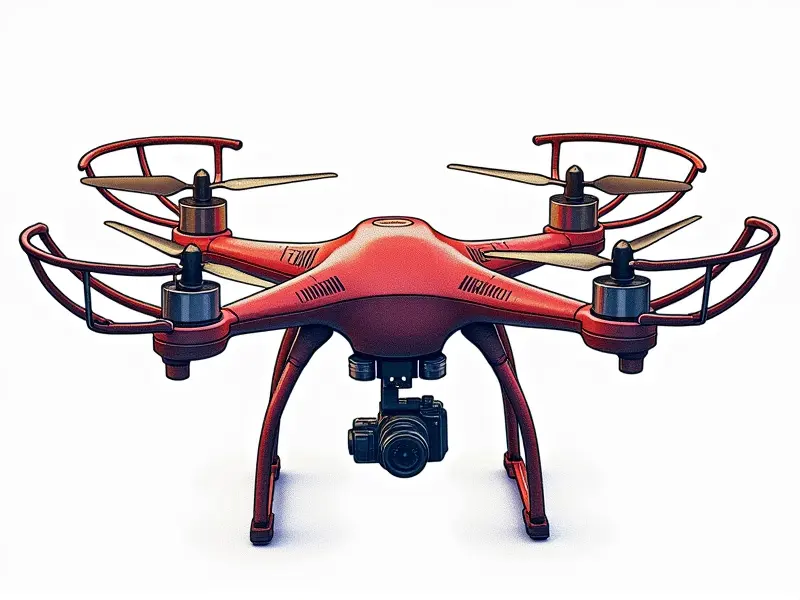Drone antenna types explained

Understanding Drone Antenna Types
Drone technology has revolutionized aerial photography and videography, offering unprecedented flexibility and reach. A crucial component of any drone setup is its antenna system, which ensures reliable communication between the ground control station and the aircraft. This article delves into various types of drone antennas, their functions, and how to select the most suitable one for your specific needs.
Different Types of Drone Antennas Explained
Drone antennas come in a variety of shapes and sizes, each designed to optimize performance under different conditions. Understanding these differences is key to maximizing the capabilities of your drone:
- Omni-directional Antennas: These are commonly used for basic communication needs due to their 360-degree coverage.
- Directional Antennas: Ideal for long-range communications, these antennas focus signal strength in a specific direction.
- Patch Antennas: Known for their compact size and high gain, patch antennas are popular among FPV (First Person View) enthusiasts.
- Yagi-Uda Antennas: These directional antennas offer excellent range but require precise alignment to maintain optimal performance.
Choosing the Right Drone Antenna
Selecting an antenna involves considering several factors such as intended use, flight distance, and environmental conditions. Here are some key points to consider:
- Frequency Band Compatibility: Ensure that your chosen antenna is compatible with your drone's frequency band.
- Gain and Directivity: Higher gain antennas provide stronger signals but may have narrower coverage angles.
- Weather Resistance: Opt for water-resistant or waterproof options if you plan to fly in adverse weather conditions.
How Drone Antennas Work
The functionality of drone antennas is based on the principles of radio frequency (RF) communication. They capture and transmit signals between the ground control unit and the drone, ensuring smooth operation:
- Signal Reception: The antenna receives RF signals from the transmitter.
- Amplification: Signals are amplified to ensure clear transmission over long distances.
- Directionality: Directional antennas focus energy in a specific direction, enhancing range and reducing interference.
Top 5 Drone Antenna Types
Here’s a list of the top five drone antenna types based on their performance and popularity among users:
- Patch Antennas: High gain, compact design suitable for FPV drones.
- Yagi-Uda Antennas: Excellent range but require precise alignment.
- Sector Antennas: Provide wide coverage in a specific direction.
- Panel Antennas: Ideal for long-range communication with high gain.
- Pi-Pi Antennas: Unique design offering both omnidirectional and directional modes.
Mastering Drone Antenna Selection
To master the selection process, it’s essential to understand your drone's requirements and operational environment. Consider factors such as flight range, signal interference, and antenna placement:
- Flight Range: Determine how far you need to communicate with your drone.
- Signal Interference: Assess the level of RF noise in your operating area.
- Antenna Placement: Optimal placement can significantly enhance performance.
Essential Guide to Drone Antennas
This comprehensive guide covers all aspects of drone antennas, from basic principles to advanced selection criteria. Whether you're a beginner or an experienced pilot, this information will help you make informed decisions:
- Basics of RF Communication: Understanding the fundamentals is crucial.
- Tuning and Calibration: Proper setup ensures optimal performance.
- Maintenance Tips: Regular checks can prevent signal degradation.
How Antennas Impact Drone Performance
The quality and type of antenna directly influence the overall performance of your drone. Poorly chosen antennas can lead to reduced range, increased latency, and compromised video quality:
- Range Limitations: Weak signals result in shorter operational distances.
- Latency Issues: Delayed responses affect control accuracy.
- Video Quality: Poor reception can degrade video clarity and stability.
Antenna Selection for FPV Drones
First Person View (FPV) drones demand high-performance antennas to deliver smooth, lag-free video transmission. Key considerations include:
- High Gain Antennas: Essential for clear and stable video feed.
- Lightweight Design: Minimizes weight impact on flight performance.
- Durable Construction: Resistant to wear and tear from frequent use.
Optimal Antennas for RC Quadcopters
Remote Control (RC) quadcopters benefit greatly from well-chosen antennas, especially in terms of control responsiveness and range. Key factors include:
- Directional Gain: Enhances signal strength over long distances.
- Weatherproofing: Ensures reliable operation under various conditions.
- Mounting Options: Easy installation and secure attachment points.
Key Features of Drone Antennas
When evaluating drone antennas, look for these key features to ensure optimal performance:
- Frequency Band Support: Compatibility with your drone’s communication system.
- Durability: Resistant to environmental factors like moisture and impact.
- Mounting Flexibility: Versatile installation options for different setups.
Conclusion
Selecting the right drone antenna is crucial for achieving reliable communication, extended range, and high-quality video transmission. By understanding the various types of antennas available and their specific features, you can enhance your drone's performance and enjoy a more seamless flying experience. Whether you're an FPV enthusiast or an RC quadcopter pilot, choosing the appropriate antenna will significantly impact your overall satisfaction with your drone.

